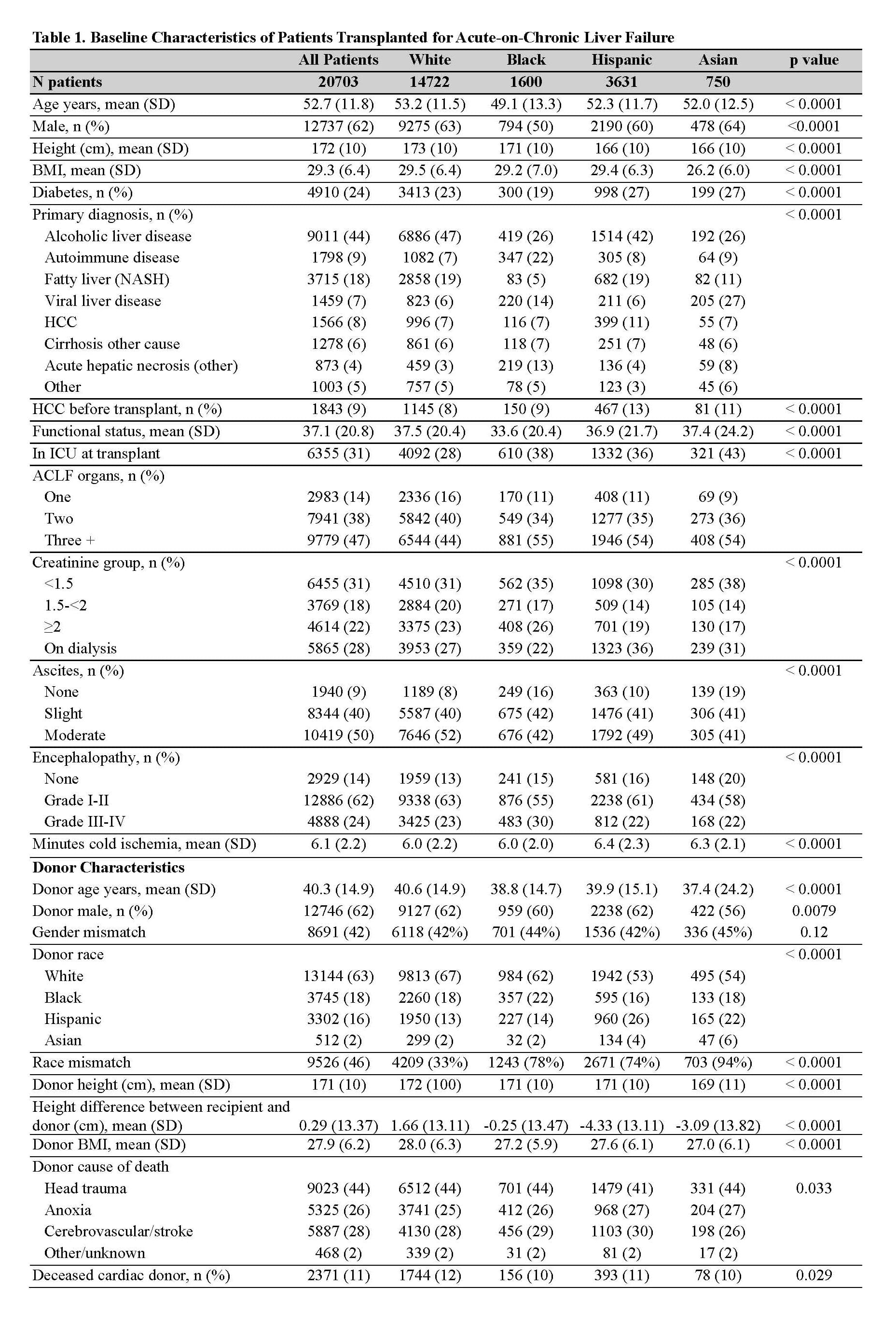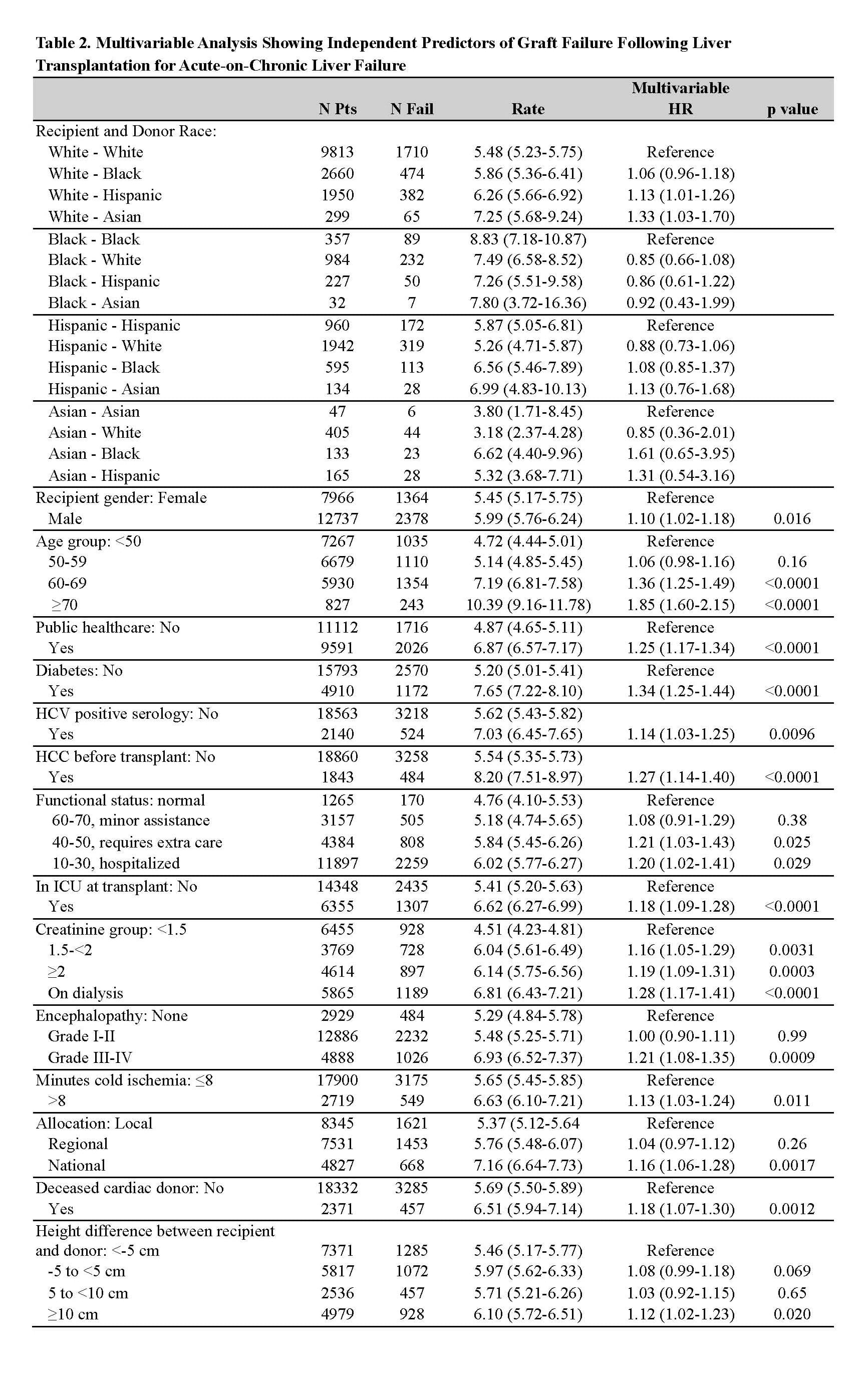Sunday Poster Session
Category: Liver
P1574 - Effect of Donor-Recipient Race Mismatch on Post-Liver Transplant Outcomes in Acute-on-Chronic Liver Failure: A Study of Organ Procurement and Transplantation Network Database
Sunday, October 26, 2025
3:30 PM - 7:00 PM PDT
Location: Exhibit Hall
- MS
Mohammed Rifat Shaik, MBBS
National Institutes of Health
Bethesda, MD
Presenting Author(s)
Mohammed Rifat Shaik, MBBS, Elizabeth C. Wright, PhD, Christine Hsu, MD
National Institutes of Health, Bethesda, MD
Introduction: Acute-on-chronic liver failure (ACLF) has high short-term mortality. Liver transplant (LT) is lifesaving. Five-year survival is variable among ACLF grades with worst post-LT outcomes with higher number of organ failures (OF). However, ACLF-3 can have comparable post-LT survival in select patients. Donor-recipient race-mismatching (DRRM) has been associated with worst post-transplant outcomes in kidney, lung, and heart transplant and among select LT populations. However, its impact on ACLF patients is not well delineated. We aim to evaluate if DRRM leads to higher risk of graft failure across the strata of ACLF patients.
Methods: The Organ Procurement and Transplantation Network (OPTN) database was queried to identify adult LT recipients during the MELD-Na allocation period (1/2016–7/2023). LT recipients with ACLF pre-LT (with atleast one OF) were included in the study. Modified European Association for the Study of the Liver (EASL) criteria for ACLF was used, which include bilirubin ≥12 mg/dL, serum creatinine ≥2 mg/dL, INR ≥2.5, hepatic encephalopathy (HE), or requirement for life support or mechanical ventilation. Primary outcome assessed was graft failure (GF). DRRM was evaluated for Whites, Blacks, Hispanics and Asians. A Cox proportional hazards regression model was used to identify independent predictors of GF.
Results: A total of 20,703 ACLF patients were identified, of whom majority were White (71.1%). 7.7% were Black, 17.5% were Hispanic, and 3.6% were Asian. Racially matched donors were observed in 67% of White, 22% of Black, 26% of Hispanic, and 6% of Asian recipients (Table 1). Among White recipients, DRRM with Hispanic donors (HR: 1.13, 95%CI 1.01–1.26), and Asian donors (HR: 1.33, 95%CI 1.03–1.70) independently predicted a higher risk of GF compared to no DRRM in the multivariable analysis (Table 2). Other independent predictors of GF were age ≥60 years, male recipient, having diabetes or hepatocellular carcinoma pre-LT, poor functional status, intensive care unit admission, creatinine ≥1.5 mg/dL or dialysis pre-LT, Grade 3-4 HE, cold-ischemia time >8 min, national allocation, deceased cardiac donor, and donor-recipient height mismatch ≥10 cm.
Discussion: In this study, Hispanic and Asian donor to White recipient mismatching independently predicted GF in those with ACLF that is not related to donor-recipient size mismatch. Our findings suggest that if multiple donors arise and if feasible, donor-recipient race matching may be preferred specifically in the White population.

Figure: Table 1. Baseline Characteristics of Patients Transplanted for Acute-on-Chronic Liver Failure

Figure: Multivariable Analysis Showing Independent Predictors of Graft Failure Following Liver Transplantation for Acute-on-Chronic Liver Failure
Disclosures:
Mohammed Rifat Shaik indicated no relevant financial relationships.
Elizabeth Wright indicated no relevant financial relationships.
Christine Hsu indicated no relevant financial relationships.
Mohammed Rifat Shaik, MBBS, Elizabeth C. Wright, PhD, Christine Hsu, MD. P1574 - Effect of Donor-Recipient Race Mismatch on Post-Liver Transplant Outcomes in Acute-on-Chronic Liver Failure: A Study of Organ Procurement and Transplantation Network Database, ACG 2025 Annual Scientific Meeting Abstracts. Phoenix, AZ: American College of Gastroenterology.
National Institutes of Health, Bethesda, MD
Introduction: Acute-on-chronic liver failure (ACLF) has high short-term mortality. Liver transplant (LT) is lifesaving. Five-year survival is variable among ACLF grades with worst post-LT outcomes with higher number of organ failures (OF). However, ACLF-3 can have comparable post-LT survival in select patients. Donor-recipient race-mismatching (DRRM) has been associated with worst post-transplant outcomes in kidney, lung, and heart transplant and among select LT populations. However, its impact on ACLF patients is not well delineated. We aim to evaluate if DRRM leads to higher risk of graft failure across the strata of ACLF patients.
Methods: The Organ Procurement and Transplantation Network (OPTN) database was queried to identify adult LT recipients during the MELD-Na allocation period (1/2016–7/2023). LT recipients with ACLF pre-LT (with atleast one OF) were included in the study. Modified European Association for the Study of the Liver (EASL) criteria for ACLF was used, which include bilirubin ≥12 mg/dL, serum creatinine ≥2 mg/dL, INR ≥2.5, hepatic encephalopathy (HE), or requirement for life support or mechanical ventilation. Primary outcome assessed was graft failure (GF). DRRM was evaluated for Whites, Blacks, Hispanics and Asians. A Cox proportional hazards regression model was used to identify independent predictors of GF.
Results: A total of 20,703 ACLF patients were identified, of whom majority were White (71.1%). 7.7% were Black, 17.5% were Hispanic, and 3.6% were Asian. Racially matched donors were observed in 67% of White, 22% of Black, 26% of Hispanic, and 6% of Asian recipients (Table 1). Among White recipients, DRRM with Hispanic donors (HR: 1.13, 95%CI 1.01–1.26), and Asian donors (HR: 1.33, 95%CI 1.03–1.70) independently predicted a higher risk of GF compared to no DRRM in the multivariable analysis (Table 2). Other independent predictors of GF were age ≥60 years, male recipient, having diabetes or hepatocellular carcinoma pre-LT, poor functional status, intensive care unit admission, creatinine ≥1.5 mg/dL or dialysis pre-LT, Grade 3-4 HE, cold-ischemia time >8 min, national allocation, deceased cardiac donor, and donor-recipient height mismatch ≥10 cm.
Discussion: In this study, Hispanic and Asian donor to White recipient mismatching independently predicted GF in those with ACLF that is not related to donor-recipient size mismatch. Our findings suggest that if multiple donors arise and if feasible, donor-recipient race matching may be preferred specifically in the White population.

Figure: Table 1. Baseline Characteristics of Patients Transplanted for Acute-on-Chronic Liver Failure

Figure: Multivariable Analysis Showing Independent Predictors of Graft Failure Following Liver Transplantation for Acute-on-Chronic Liver Failure
Disclosures:
Mohammed Rifat Shaik indicated no relevant financial relationships.
Elizabeth Wright indicated no relevant financial relationships.
Christine Hsu indicated no relevant financial relationships.
Mohammed Rifat Shaik, MBBS, Elizabeth C. Wright, PhD, Christine Hsu, MD. P1574 - Effect of Donor-Recipient Race Mismatch on Post-Liver Transplant Outcomes in Acute-on-Chronic Liver Failure: A Study of Organ Procurement and Transplantation Network Database, ACG 2025 Annual Scientific Meeting Abstracts. Phoenix, AZ: American College of Gastroenterology.
